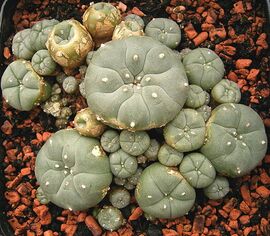Lophophora williamsii
Please avoid harvesting peyote in its natural habitat. Peyote populations are rapidly declining in nature due to over-harvesting by non-indigenous peoples. As a result, it is currently a threatened species.[1][2] Those who wish to consume peyote are encouraged to grow their own or use alternative mescaline-containing cactus species such as San Pedro or Peruvian Torch. |
| Lophophora williamsii | |
|---|---|
|
Peyote in a pot. |
|
| Taxonomical nomenclature | |
| Kingdom | Plantae |
| Unranked | Angiosperms |
| Unranked | Eudicots |
| Unranked | Core eudicots |
| Order | Caryophyllales |
| Family | Cactaceae |
| Genus | Lophophora |
| Species | L. williamsii |
| Common nomenclature | |
| Common names | Peyote, Peyotel (in Latin America) |
| Constituents | |
| Active constituents | Mescaline, Pellotine, Hordenine, etc. |
Lophophora williamsii, also known as peyote or peyotel, is a slow growing spineless cactus with psychoactive alkaloids like mescaline and pellotine.[3] Native North Americans are likely to have used peyote, often for spiritual purposes, for at least 5,500 years.[4]
Distribution and habitat
The natural distribution area of L. williamsii lies in the Chihuahuan Desert in northeastern Mexico and southwest Texas (USA) with over 80% of the geographical area being Mexican territory. It reaches from Trans-Pecos Texas the most northern extent down south to San Luis Potosí (Mexico).[5] It is hypothesized that mescaline contents follow a geographical gradient. Unfortunately, many populations are decreasing in number and size of individuals which is attributed to an apparently increased harvesting pressure.[5][6] It is found at elevations of 100 to 1,500m and its habitat is desertscrub being commonly associated with limestone.[7]
Etymology
The word peyote is the Spanish form of the ancient Nahuatlan word peyotl. Some etymologist suggested that this word is derived from the aztec word "pepeyoni" (means to excite) or "pepeyon" (to activate).[8] de Molina claimed that it is derived from the Nahuatlan word "peyutl" which means "silk cocoon or caterpillar's cocoon".[9]
External links
References
- ↑ Martin Terry (Sul Rose State Univ., A. (19 November 2009). "IUCN Red List of Threatened Species: Lophophora williamsii". IUCN Red List of Threatened Species.
- ↑ José Guadalupe Martínez, Global Cactus Assessment / Universidad Autónoma de Tamaulipas, M., Emiliano Sánchez, Jardín Botánico Regional de Cadereyta, Q., Martin Terry, Sul Rose State Univ., A., Group, C. G.-H., IUCN S. C. & S. P. S. (18 November 2009). "IUCN Red List of Threatened Species: Lophophora diffusa". IUCN Red List of Threatened Species.
- ↑ Fujita, M., Itokawa, H., Inoue, J., Nozu, Y., Goto, N. (April 1972). "[On the cactus-alkaloids of Lophophora williamsii var. caespitosa (kobuki-ubadama)]". Yakugaku Zasshi: Journal of the Pharmaceutical Society of Japan. 92 (4): 482–489. doi:10.1248/yakushi1947.92.4_482. ISSN 0031-6903.
- ↑ El-Seedi, H. R., Smet, P. A. G. M. D., Beck, O., Possnert, G., Bruhn, J. G. (October 2005). "Prehistoric peyote use: Alkaloid analysis and radiocarbon dating of archaeological specimens of Lophophora from Texas". Journal of Ethnopharmacology. 101 (1–3): 238–242. doi:10.1016/j.jep.2005.04.022. ISSN 0378-8741.
- ↑ 5.0 5.1 Terry, Martin & Trout, Keeper & Williams, B. & Herrera, T. & Fowler, Norma. (2011). Limitations to natural production of Lophophora williamsii (Cactaceae) I. Regrowth and survivorship two years post harvest in a south Texas population. Journal of the Botanical Research Institute of Texas. 5. 661-675.
- ↑ Hulsey, Diana, et al. “Clinal geographic variation in mescaline concentration among Texas population of Lophophora williamsii (Cactaceae).” Journal of the Botanical Research Institute of Texas, vol. 5, no. 2, 2011, pp. 677–83.
- ↑ Zimmerman, Allan D.; Parfitt, Bruce D. (2006). "Lophophora williamsii". Flora of North America. Vol. 4. Oxford: Oxford University Press. p. 242.
- ↑ Schultes, R. E. (19 November 1937). "Peyote (Lophophora williamsii) and Plants confused with it". Botanical Museum leaflets, Harvard University. 5 (5): 61–88. doi:10.5962/p.295106. ISSN 0006-8098.
- ↑ Anderson, E. F. (1996). Peyote: the divine cactus (2nd ed ed.). University of Arizona Press. ISBN 9780816516537.
